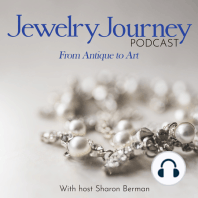17 min listen

Episode 162 Part 2: Why Fair Trade Is the Gold Standard for Ethical Jewelry
Episode 162 Part 2: Why Fair Trade Is the Gold Standard for Ethical Jewelry
ratings:
Length:
28 minutes
Released:
Jul 15, 2022
Format:
Podcast episode
Description
What you’ll learn in this episode: Why an empty mind is the key to creative exploration The difference between an artist-jeweler and a jeweler or artist alone What fair-trade gold is, and how Ute became a pioneer in the ethical jewelry movement Why greenwashing is the newest trend threatening the ethical jewelry market How jewelry creates connections, even when someone wouldn’t wear a piece themselves About Ute Decker Ute Decker, born 1969, Germany, lives and works in London, UK. The jewels of Ute Decker are described as “a powerful statement” that “sets a shining ethical example” (Financial Times). The Economist 1843 compares her “avant-garde sculptural pieces” to “swirling sculptures” while Christie’s simply calls them “wearable works of art”. Ute’s pieces are exhibited internationally and have won prestigious awards including Gold Awards from The Goldsmiths’ Craft and Design Council, UK. Public collections include the Victoria & Albert Museum, UK; the Crafts Council, UK; the Goldsmiths’ Company, UK; the Spencer Museum, USA; Musée Barbier-Mueller, Switzerland; and the Swiss National Museum. As a political economist-turned-journalist-turned-artist jeweler, Ute Decker is a pioneer of the international ethical jewelery movement. She works predominately in recycled silver and was one of the first worldwide to work in Fairtrade Gold. Additional Resources: Website Instagram Ute’s Facebook Ute’s Jewelry Facebook Photos Available on TheJewelryJourney.com Transcript: When it comes to ethical jewelry, artist-jeweler Ute Decker is the real deal. She was one of the first people to use fair-trade gold when it became available in the U.K., and she has spent her career advocating for the use of truly ethically sourced materials in the jewelry industry. Above all, she’s proven that ethical can be beautiful: her sculptural works have won several awards and are in the collection of museums worldwide. She joined the Jewelry Journey Podcast to talk about what fair trade means; how she approaches the creative process; and what makes an artist-jeweler. Read the episode transcript here. Sharon: Hello, everyone. Welcome to the Jewelry Journey Podcast. This is the second part of a two-part episode. If you haven’t heard part one, please go to TheJewelryJourney.com. Today my guest is Ute Decker, talking with us from London. Ute is an artist-jeweler who’s known for her innovative method of sculpting, bending and twisting metal into three-dimensional, wearable sculptures. She works in fair-trade gold and recycled silver and is considered a pioneer in the international ethical jewelry movement. Welcome back. So how did all of this lead you into recycled material? Was that something you decided you wanted to do, and that was it? How did it happen? Ute: As we talked about at the beginning, as a teenager, I wanted to change the world. I was always quite environmentally mindful. Then studying political economics, working as a journalist, you think that is very far removed from being a creative, and at the time it certainly felt like a big break, but in hindsight I think it was an important apprenticeship I needed to take to become the jeweler I am today. As in political economics, you don’t just look at the piece and take it as art for art’s sake or design for design’s sake. You want to know the meaning, the context, the economic, the social, the political, the gender. All those different histories and intersectionalities, that’s my training to look at those. As a journalist, your training is to ask questions, so when I started out making jewelry, I did ask questions. Like many people, I’ve seen the film “Blood Diamonds,” and I thought, “Oh well, thank god I don’t work with diamonds. I work with metals.” Then I started to look into gold, and the story is very similar to “Blood Diamonds” with gold. Of course, my reaction was, “I can’t possibly work with this kind of material. I can’t be part of the status quo. I’d have blood on my hands. It’s
Released:
Jul 15, 2022
Format:
Podcast episode
Titles in the series (100)
Episode 1: The Importance of Antique & Estate Jewelry Today with Jewelry Appraiser Edward Lewand: Edward A. Lewand, GG, ASA, AAA, is a professional, independent appraiser of fine and antique jewelry. He works with attorneys on estates, trusts, insurance matters and copyright issues; appraisal theories and concepts; and matrimonial appraising.... by Jewelry Journey Podcast